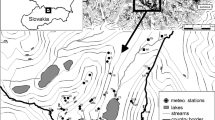Abstract
The heterogeneous vegetation mosaic of the South Turkana region of north Kenya is associated with diversity in the region's physical environment. The abundance and distribution of the dominant species are related to gradients in those abiotic factors that influence water availability, including precipitation, soil texture, and topographic relief. Research focused on three Acacia species that are a major component of the Turkana vegetation; A. tortilis, A. senegal, and A. reficiens. These species each exhibit a different response to variations in abiotic factors. Consequently, species abundance varies independently across the landscape, creating a continuum of intergrading populations. Community types can be identified within the mosaic of intergrading populations. Although community borders are not discrete due to continual change in species abundance, types are identifiable and are repeated in areas with similar environmental conditions. The landscape patterns are representative of Whittaker's (1953) climaxas-pattern, with communities created by individual patterns of populations responding to environmental gradients, creating a continuum of community change across the landscape.
Similar content being viewed by others
References
Austin, M. P. 1980. Searching for a model for use in vegetation analysis. Vegetatio 42: 11–21.
Austin, M. P. & Smith, T. M. 1989. A new model for the continuum concept. Vegetatio 83: 35–47.
Belsky, A. J. 1989. Landscape patterns in a semi-arid ecosystem in East Africa. J. Arid Environ. 17: 265–270.
Barkham, J.P. & Rainy, M. E. 1976. The vegetation of the Samburu-Isiolo Game Reserve. East Afr. Wildl. J. 14: 297–329.
Bornkamm, R. & Kehl, H. 1989. Landscape ecology of the western desert of Egypt. J. Arid Environ. 17: 271–277.
Brown, J. H. 1988. Species diversity. In: A. A.Myers & P. S.Giller (eds.), Analytical biogeography. London: Chapman and Hall.
Chorley, R. J., Schumm, S. A. & Sugden, D. E. 1984. Geomorphology. New York: Methuen.
Cody, M. L. 1989. Growth-form diversity and community structure in desert plants. J. Arid Environ. 17: 199–209.
Cole, M. M. 1986. The Savannas: Biogeography and Geobotany. London: Academic Press.
Cooke, R. U. & Warren, A. 1973. Geomorphology in Deserts. Berkeley: University of California Press.
Cooper, C. F. 1957. The variable plot method for estimating shrub density. J. Range Manage. 10: 111–115.
Coppinger, K. 1987. Geomorphic control of distribution of woody vegetation and soil moisture in Turkana District, Kenya. Masters Thesis. Colorado State University, Fort Collins, CO, USA.
Coughenour, M. B., Coppock, D. L. & Ellis, J. E. 1990. Herbaceous forage variability in an arid pastoral region Kenya: importance of topographic and rainfall gradients. J. Arid Environ. 19: 147–159.
Daubenmire, R. 1966. Vegetation: identification of typal communities. Science 151: 291–298.
Ellis, J. E. & Dick, O. 1985. The vegetation of Turkana District: a LANDSAT analysis. Report to NORAD, Oslo.
Grieg-Smith, P. 1983. Quantitative Plant Ecology, 3rd ed. Berkeley, CA: Blackwell.
Hill, M. O. 1979. DECORANA-AFORTRAN program for detrended correspondence analysis and reciprocal averaging. Ithaca, NY: Cornell University.
Joubert, P. 1966. Geology of the Loperot Area. Report No. 74. Ministry of Natural Resources, Geological Survey of Kenya, Nairobi.
Lind, E. M. & Morrison, M. E. S. 1974. East African Vegetation. Longman Group Ltd., London.
Mabbutt, J. A. 1977. Desert Landforms. Cambridge, MA. MIT Press.
Noy-Meir, I. 1973. Desert ecosystems: environment and producers. Ann. Rev. Ecol. Syst. 4: 25–51.
Noy-Meir, I. 1974. Multivariate analysis of the semi-arid vegetation in south-eastern Australia. II. Vegetation catenae and environmental gradients. Aust. J. Bot. 22: 115–140.
Noy-Meir, I. 1981. Spatial effects in modelling of arid ecosystems. In: D. W. Goodall & R. A. Perry (eds.), Arid Land Ecosystems: Structures, Functioning, and Management, vol. 2. Cambridge University Press.
Noy-Meir, I. & Van derMaarel. 1987. Relations between community theory and community analysis in vegetation science: some historical perspectives. Vegetatio 69: 5–15.
Patten, R. S. 1991. Pattern and process in an arid tropical ecosystem: a landscape analysis of Ngisonyoka Turkana, Kenya. Ph.D. dissertation. Colorado State University, Fort Collins.
Walker, B. H. & Noy-Meir, I. 1982. Aspects of the stability and resilience of savanna ecosystems. In: B. J.Huntley & B. H.Walker (eds.), Ecology of Tropical Savannas. New York: Springer Verlag.
Westoby, M. 1979. Elements of a theory of vegetation dynamics in arid rangelands. Israel J. Bot. 28: 169–194.
Whittaker, R. H. 1953. A consideration of climax theory: the climax as a population and pattern. Ecol. Mono. 23: 41–61.
Whittaker, R. H. & Levin, S. A. 1977. The role of mosaic phenomena in natural communities. Theor. Pop. Biol. 12: 117–139.
Wiens, J. A. 1985. Vertebrate responses to environmental patchiness in arid and semiarid ecosystems. In: S. T. A.Pickett & P. S.White (eds.), The Ecology of Natural Disturbance and Patch Dynamics. New York: Academic Press.
Yair, A. & Dannin, A. 1980. Spatial variation as related to the soil moisture regime over an arid limestone hillside, northern Negev, Israel. Oecologia 47: 83–88.
Author information
Authors and Affiliations
Rights and permissions
About this article
Cite this article
Patten, R.S., Ellis, J.E. Patterns of species and community distributions related to environmental gradients in an arid tropical ecosystem. Vegetatio 117, 69–79 (1995). https://doi.org/10.1007/BF00033260
Accepted:
Issue Date:
DOI: https://doi.org/10.1007/BF00033260




